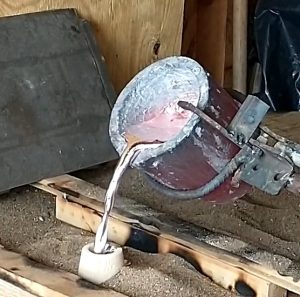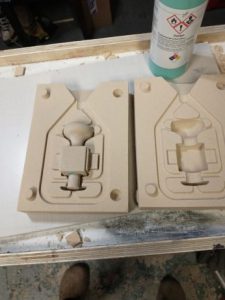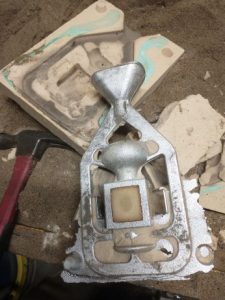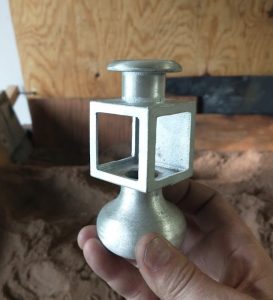 Sand Casting is an art that has been around since the beginning of recorded time. Molten metals have been taking shape using the simple sand particle as a form die for a myriad of uses from swords, axe heads, crank shafts, airplane engine parts etc… Nearly anything that has a complicated shape owes its form to the sand cast process.
Sand Casting is an art that has been around since the beginning of recorded time. Molten metals have been taking shape using the simple sand particle as a form die for a myriad of uses from swords, axe heads, crank shafts, airplane engine parts etc… Nearly anything that has a complicated shape owes its form to the sand cast process.
The reason sand casting is so prevalent is that the sand particle is resistant to the heat and does not change shape when molten metals are poured up against it. (This is not true for all metals….as some can turn the contact surface of sand into glass). Aluminum and brass is what is used primarily at Prototype Industries for foundry work. Under special circumstances we work with Steel and Iron foundries to develop other parts. (If interested Contact us for details.)
The basics problem with casting high temperature melting metals is finding material that can maintain the shape to make a part. The maintaining the shape is critical for making repeatable parts. Finding a material that melts above the temperature of molten metal is one solution. Sand is a prime candidate because its glass transition temperature is way above molten metals, it is readily available, and it bonds together easily maintaining its shape when confronted with molten metals.
Sand is bound together with various methods, the simplest being the compaction method. Actually, the sand is mixed with various constituents such as clay, saw dust, water and other ingredients to make a mixture that will stick together, or even be baked together, when molten metals hit it. Compaction is the critical element in this method and requires pounding compaction, or hydraulic press coupled with strong molds to resist the compaction forces. This method does require intensive capital investment.
The methods for binding sand together that are more production worthy and less capital intensive use simple chemicals that act as glue to bind the particles together. As a result massive compressive loads are not required to make the sand molds.
The two most common methods are sodium silicate mixtures and urethane binding mixtures. Both systems are employed in our prototyping process. The urethane method being preferred for rapid development of durable sand molds.
However, sodium silicate method is used for high temperature castings such as brass. The brass can overheat the urethane binder making the part degrade at entry, and even warp the part-mold.
In our processes here, we use chemical methods to bind the sand together. The sand is mixed with the chemical binder and then placed into molds. The chemical reaction for sodium silicate takes about 2 hours, where the urethane method takes about 25 minutes before the tools can be demolded.
Forming the sand into the proper shape in our case uses simple face molds where the sand mixture is packed into the molds and then allowed to set.
The mold pieces then are glued together, spouts glued on and then the molds are brought to the foundry area and prepped further for casting. The molds to keep them from falling apart are clamped.
 Once the molten metal has been poured into the molds, the parts can be broken free from the sand molds in about 10 minutes to ensure the part itself has crystalized internally, or hardened. If the parts are demolded too quickly they can deform and bend.
Once the molten metal has been poured into the molds, the parts can be broken free from the sand molds in about 10 minutes to ensure the part itself has crystalized internally, or hardened. If the parts are demolded too quickly they can deform and bend.
Cleaning the part requires a hard strike with a hammer to vibrationally dislodge the sand. The best method to keep the sand from sticking to the part is to coat the mold with a sodium silicate spray or a foundry release agent.
The acceptional quality of the parts that emerge from sand casting is remarkable. If the calculations are performed properly for shrink, the parts typically come in very consitent in shape and dimension.
If more accurate shapes are required like threaded holes, reamed out holes the parts will require secondary machining.
If a part is hollow, which the majority of the parts we make are, sand cores or solid metal cores are developed. A sand core is simply a hardened sand shape that fills the void of the part. Our crank for example uses a sand core in the main pivot section. Our lamp also has a sophisticated sand core to keep the part hollow.



